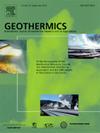Experimental investigation on the elastic-plastic failure evolution mechanism of high-temperature hot dry rocks using combined monitoring of acoustic emission and digital image correlation
IF 3.5
2区 工程技术
Q3 ENERGY & FUELS
引用次数: 0
Abstract
Hot dry rock (HDR) is a resource-rich, renewable, and clean energy source characterized by its great depth, high temperature, and high geostress. In underground environments, rocks are prone to significant elastoplastic deformation. However, research on the elastoplastic deformation, failure, and fracture mechanisms of HDR under high-temperature conditions remains limited. This study employs Acoustic Emission (AE) and Digital Image Correlation (DIC) as combined monitoring methods to conduct fracture toughness experiments on granite semicircular bend (SCB) specimens under high-temperature conditions. We obtained load-displacement curves, AE parameters, and strain fields near crack tips at various temperatures to reveal the mechanical mechanisms of elastic-plastic failure evolution in HDR. Experimental results indicate that both the peak load and fracture toughness of granite specimens decrease gradually with increasing temperature, with the peak load at 600 °C being 69.1 % lower than at 25 °C. DIC results show that the fracture process zone at the crack tip enlarges with rising temperature, while strain and crack width values decrease. Additionally, the attenuation of AE b-values at peak load relative to the initial loading phase increases, and the proportion of shear failure increases, with a maximum increase of up to 42.3 %. As temperature rises, the failure mechanism of artificial fractures transitions from brittle macroscopic fractures to plastic fine fractures. When the temperature exceeds 400 °C, plastic failure becomes more pronounced, with numerous microcracks forming and further coalescing into complex main cracks. This study provides important theoretical support for the efficient development of deep geothermal resources.
基于声发射和数字图像相关联合监测的高温干热岩弹塑性破坏演化机制实验研究
干热岩具有深度大、温度高、地应力大的特点,是一种资源丰富、可再生的清洁能源。在地下环境中,岩石容易发生显著的弹塑性变形。然而,高温条件下HDR的弹塑性变形、破坏和断裂机制的研究仍然有限。采用声发射(AE)和数字图像相关(DIC)相结合的监测方法,对花岗岩半圆弯(SCB)试样在高温条件下进行断裂韧性实验。我们获得了不同温度下的载荷-位移曲线、声发射参数和裂纹尖端附近的应变场,以揭示HDR弹塑性破坏演化的力学机制。试验结果表明,随着温度的升高,花岗岩试样的峰值载荷和断裂韧性逐渐降低,600℃时的峰值载荷比25℃时降低了69.1%。DIC结果表明,裂纹尖端的断裂过程区随着温度的升高而扩大,应变值和裂纹宽度值则减小。峰值加载阶段声发射b值相对初始加载阶段衰减增大,剪切破坏比例增大,最大增幅可达42.3%。随着温度的升高,人工裂缝的破坏机制由脆性宏观断裂向塑性细碎断裂转变。当温度超过400℃时,塑性破坏更加明显,形成大量微裂纹并进一步合并成复杂的主裂纹。该研究为深部地热资源的高效开发提供了重要的理论支持。
本文章由计算机程序翻译,如有差异,请以英文原文为准。
求助全文
约1分钟内获得全文
求助全文
来源期刊

Geothermics
工程技术-地球科学综合
CiteScore
7.70
自引率
15.40%
发文量
237
审稿时长
4.5 months
期刊介绍:
Geothermics is an international journal devoted to the research and development of geothermal energy. The International Board of Editors of Geothermics, which comprises specialists in the various aspects of geothermal resources, exploration and development, guarantees the balanced, comprehensive view of scientific and technological developments in this promising energy field.
It promulgates the state of the art and science of geothermal energy, its exploration and exploitation through a regular exchange of information from all parts of the world. The journal publishes articles dealing with the theory, exploration techniques and all aspects of the utilization of geothermal resources. Geothermics serves as the scientific house, or exchange medium, through which the growing community of geothermal specialists can provide and receive information.
 求助内容:
求助内容: 应助结果提醒方式:
应助结果提醒方式:


